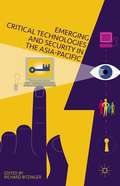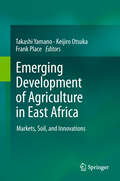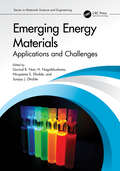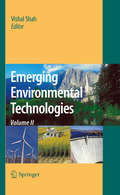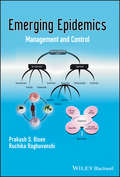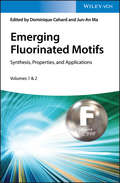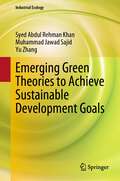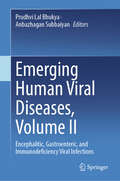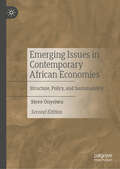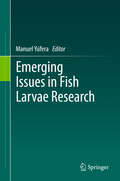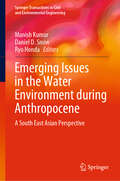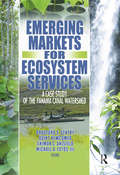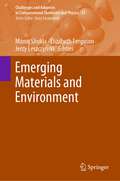- Table View
- List View
Emerging Contaminants: Anticipating Developments
by Kathleen Sellers Denice K. Nelson Nadine WeinbergEmerging Contaminants: Anticipating Developments examines the factors that have led "new" environmental contaminants to emerge in the past and combines the lessons learned to anticipate potential new developments. The analyses described in this book originate in multiple disciplines: the science of toxicology; environmental law and regulation; the field of product stewardship; and the social science which explains why ideas take hold. Over a dozen case studies of contaminants that emerged as environmental issues over the last hundred years illustrate crucial points. The results of the analyses in this book support a step-by-step method to assess the potential for a contaminant to emerge, and a framework to apply those conclusions to managing site liabilities. Features: Describes an unprecedented understanding of why contaminants emerge as issues, based on a multidisciplinary analysis Makes abstract concepts tangible, basing analyses on data and illustrating key points with case studies Enables readers to anticipate and prepare to manage future challenges associated with emerging chemicals Presents an analytical framework for companies to assess and manage business risks Written for regulators, policymakers, industry professionals with responsibility for contaminated site management, as well as attorneys, and consultants, this book provides a framework for anticipating the emergence of new contaminants so that the risks–whether to human health and the environment or to a business–can be anticipated and appropriately managed.
Emerging Critical Technologies and Security in the Asia-Pacific
by Richard BitzingerThe proliferation of advanced militarily relevant technologies in the Asia-Pacific over the past few decades has been a significant, and perhaps even alarming, development. This volume addresses how such technologies may affect military capabilities and military advantage in the region.
Emerging Development of Agriculture in East Africa
by Frank Place Keijiro Otsuka Takashi YamanoEmerging Development of Agriculture in East Africa offers case studies that find promise in many new innovations. Farmers in Uganda have quickly learned the management of NERICA rice (a new upland rice variety), which is being disseminated in a limited way in the region. Also in Uganda, farmers living in more remote areas have improved access to markets due to the expansion of mobile phones. In Kenya, improved milk marketing systems have increased efficiency and led to tangible increases in the adoption of dairy production technologies. And the adoption of intensive dairy production systems in Kenya and Uganda are providing significant amounts of manure and positively impacting yields of maize and banana.
Emerging Dimensions of Technology Management
by K B AkhileshTechnology is the key driver of business. May it be airport, ICT , smart governance, manufacturing or plantations. Technology management opens up opportunities for the business and help achieve leadership positions. This collection of papers provides a glimpse of issues faced in different sectors. These papers also should inspire more researchers to expand the scope of the subject itself.
Emerging Dynamics: Science, Energy, Society and Values
by Loucas G. ChristophorouEmerging Dynamics: Science, Energy, Society and Values focuses on the impact of science, science-based technology and scientific values on present-day humanity and its future. The book advocates for a science willing to accommodate both human values and scientific facts. The four main subjects focused on throughout the text are:The overwhelming impact of modern science and science-based technology on virtually every aspect of human lifeHuman values and their significance for science and societyThe need for mutual accommodation between scientific values and the traditional values of societyThe fundamental role of energy for civilization and society.The book cuts across scientific disciplines and looks at modern civilization through the knowledge provided by the physical, chemical, biomedical and other branches of natural science. The book is unique in its holistic approach, combining knowledge acquired by deduction, reduction-induction, and experimental scientific methods with knowledge acquired through history, philosophy, the arts, faith and cultural traditions. Modern civilization’s most distinct characteristics are due to science, science-based technology and energy. The role of energy in the sustainability of civilization and the impact of biomedical science on man are especially emphasized throughout this timely book, making a case for a hopeful future based on both science and values. A science guided in its applications by human values and a value system cognizant of the facts of science and willing to accommodate them
Emerging Eco-friendly Green Technologies for Wastewater Treatment (Microorganisms for Sustainability #18)
by Ram Naresh BharagavaAs we know, rapid industrialization is a serious concern in the context of a healthy environment and public health due to the generation of huge volumes of toxic wastewater. Although various physico-chemical and biological approaches are available for the treatment of this wastewater, many of them are not effective. Now, there a number of emerging ecofriendly, cost-effective approaches utilizing microorganisms (bacterial/fungi/algae), green plants or their enzymes, and constructed wetland treatment systems in the treatment of wastewaters containing pollutants such as endocrine disrupting chemicals, toxic metals, pesticides, dyes, petroleum hydrocarbons and phenolic compounds. This book provides a much-needed, comprehensive overview of the various types of wastewater and their ecotoxicological effects on the environment, humans, animals and plants as well as various emerging and eco-friendly approaches for their treatment. It provides insights into the ecological problems and challenges in the treatment and management of wastewaters generated by various sources.
Emerging Economic Models for Sustainable Businesses: A Practical Approach (Responsible Leadership and Sustainable Management)
by René Schmidpeter Nayan Mitra Jayati TalapatraThe book discusses new and emerging economic models, that respond to 'Pulling' and 'Pushing' forces. Today we are poised at an interesting juncture, with favourable conditions making it easier to be a sustainable organization acting as a ‘Pulling’ Force and the climate crisis, rise in social-economic equities thereby ‘Pushing’ for urgent action. The book analyses economic models that look at value propositions, creation and capture with ‘People, Planet and Profit’ deeply embedded in each stage of the value chain. The contributions bring out the interplay between new standards, evaluation frameworks, technology innovation and other emerging tools to show how they create a sustainable business. For this, they lean on learnings from successful sustainable businesses. Business leaders will find that this book provides deep insights on improving their existing sustainable practices, and speeding up the transition from linear to circular, narrow stakeholder driven to community driven. For prospective entrepreneurs the book provides the nudge needed to start up a sustainable enterprise. Students and researchers can benefit from real-life examples of how sustainable transformations unfold.The book thus creates an easy guide for those willing to make the transition to sustainability, start a sustainable business and most of all, to motivate those who may not yet be convinced about the long-term sense of taking care of our people and our earth.
Emerging Electromagnetic Technologies for Brain Diseases Diagnostics, Monitoring and Therapy
by Lorenzo Crocco Irene Karanasiou Michael L James Raquel Cruz ConceiçãoThis timely book presents innovative technologies for use in the diagnosis, monitoring, and treatment of brain disease. These technologies offer exciting possibilities in the medical field owing to their low-cost, portability and safety. The authors address cerebrovascular diseases such as stroke, ischemia, haemorrhage, and vasospasm, these diseases having an ever-increasing societal relevance due to the global ageing population. The authors describe the potential of novel techniques such as microwave imaging and present innovative modalities for treatment of brain tumours using electromagnetic fields and nano-composites, as well as for monitoring brain temperature during surgery. Finally, Emerging Electromagnetic Technologies for Brain Diseases Diagnostics, Monitoring and Therapy addresses the perspectives which arise from multi-modal multi-spectral EM modalities, which make a synergic use of the different portions of the electromagnetic spectrum. This text will be of interest to readers from various different areas, given the fundamental interdisciplinarity of the subject matter. This includes researchers or practitioners in the field of electrical engineering, applied physicists, and applied mathematicians working on imaging applications for biomedical and electromagnetic technologies. Neurologists and radiologists may also find this book of interest, as may graduate students in these areas.
Emerging Energy Materials: Applications and Challenges (Series in Materials Science and Engineering)
by Sanjay J. Dhoble Govind B. Nair H. Nagabhushana Nirupama S. DhobleEmerging Energy Materials: Applications and Challenges guides the reader through materials used in progressive energy systems.It tackles their use in energy storage across solar, bio, geothermal, wind, fossil, hydrogen, nuclear, and thermal energy. Specific chapters are dedicated to energy reaping systems currently in development. This book contributes to the current literature by highlighting concerns that are frequently overlooked in energy materials textbooks. Awareness of these challenges and contemplation of possible solutions is critical for advancing the field of energy material technologies.Key features: Provides up-to-date information on the synthesis, characterization, and a range of applications using various physical and chemical methods Presents the latest advances in future energy materials and technologies subjected to specific applications Includes applied illustrations, references, and advances in order to explain the challenges and trade-offs in the field of energy material research and development Includes coverage of solar cell and photovoltaic, hydro power, nuclear energy, fuel cell, battery electrode, supercapacitor and hydrogen storage applications This book is a timely reference for researchers looking to improve their understanding of emerging energy materials, as well as postgraduate students considering a career within materials science, renewable energy and materials chemistry.
Emerging Environmental Technologies, Volume II
by Vishal ShahWhile numerous journals and books are available in the market highlighting the developments in the field of environmental technology, none of them exclusively focuses on the technologies that would be in the forefront in near to far future. Each and every article in the book is peer-reviewed and from a different sub-discipline. Because of its interdisciplinary topics on for instance air pollution and energy production, this makes it a one book for all and serves as an excellent resource for scientists, entrepreneurs, politicians and non-governmental organizations who wish to gain information on upcoming and promising technologies.
Emerging Epidemics: Management and Control
by Prakash S. Bisen Ruchika RaghuvanshiA global perspective on the management and prevention of emerging and re-emerging diseases Emerging infectious diseases are newly identified or otherwise previously unknown infections that cause public health challenges. Re-emerging infectious diseases are due to both the reappearance of and an increase in the number of infections from a disease that is known, but which had formerly caused so few infections that it was no longer considered a public health problem. The factors that cause the emergence or re-emergence of a disease are diverse. This book takes a look at the world's emerging and re-emerging diseases. It covers the diagnosis, therapy, prevention, and control of a variety of individual diseases, and examines the social and behavioral issues that could contribute to epidemics. Each chapter focuses on an individual disease and provides scientific background and social history as well as the current basics of infection, epidemiology, and control. Emerging Epidemics: Management and Control offers five topics of coverage: FUNDAMENTALS Epidemics fundamentals Disasters and epidemics Biosafety RE-EMERGING EPIDEMICS Tuberculosis Plague NEWLY EMERGING EPIDEMICS Leptospirosis Dengue Japanese Encephalitis Chikungunya Fever West Nile Virus Chandipura Virus Encephalitis Kyasanur Forest Disease Hantavirus Human, Avian, and Swine Influenza Severe Acute Respiratory Syndrome Nipah Virus Paragonimiasis Melioidosis POTENTIAL EPIDEMICS Biowarfare and bioterrorism Food contamination and food terrorism Antimicrobial resistance VECTOR CONTROL METHODS Mosquito control Other disease vectors and their control Offering an integrated, worldwide overview of the complexity of the epidemiology of infections, Emerging Epidemics will be a valuable resource for students, physicians, and scientists working in veterinary, medical, and the pharmaceutical sciences.
Emerging Fluorinated Motifs, 2 Volume Set: Synthesis, Properties and Applications
by Dominique Cahard Jun-An MaA must-have resource for all the researchers working in the organofluorine and related fields This timely two-volume set uniquely focuses on emerging fluorinated motifs beyond R-CF3 and R-F, like R-CF2H, R-OCF3, R-SCF3 and R-SF5. It also offers descriptions of the properties, synthesis, and applications of these emerging fluorinated motifs in order to help readers design new chemical entities, while providing new interest for researchers in organofluorine chemistry and new tools for those in other areas. Emerging Fluorinated Motifs: Synthesis, Properties and Applications begins with a description of carbon-linked fluorine-containing groups that include monofluoromethyl and difluoromethyl groups. It then details combinations of heteroatoms, Oxygen, Sulfur, Selenium, Nitrogen, and Phosphorus with fluorine-containing groups, outlining subsections of the most popular current motifs. Fluoroalkyl ethers, thioethers, and the recent blossoming of the SF5 unit is covered. Other chapters look at: selenium-linked fluorine-containing motifs; construction of N?CF2H, N?CF3, N?CH2CF3 motifs; and the synthesis and applications of P¿Rf-containing molecules. -Focuses on the synthesis, properties, and applications of emerging fluorinated motifs -Covers carbon-linked fluorine-containing motifs, oxygen-linked fluorine-containing motifs, sulfur-linked fluorine-containing motifs, and more -Appeals to academic and industrial researchers working in organic chemistry, medicinal chemistry, food chemistry, and materials science -Edited by world-renowned experts in organofluorine chemistry Emerging Fluorinated Motifs is intended for academic research institutes, university libraries, researchers, graduate students, postdoctors, and researchers in the chemical industry.
Emerging Food Authentication Methodologies Using GC/MS
by Kristian PastorThis edited book provides an overview of existing and emerging gas chromatography/mass spectrometry (GC/MS) based methods for the authentication and fraud detection in all major food groups and beverages. Split in four parts, the book opens with a comprehensive introduction into the GC/MS technique and a summary of relevant statistical and mathematical models for data analysis. The main parts focus on the authentication of the main food groups (cereals, dairy products, fruit, meat, etc.) and beverages (e.g., coffee, tea, wine and beer). The chapters in these sections follow a distinct structure describing the nutritional value of the product, common fraud practices, economic implications and relevant biomarkers for the authentication process, such as volatile compounds, fatty acids, amino acids, isotope ratios etc. The final chapter provides an outlook on where the methodologies and the applications may be heading for. Food fraud is serious problem that affects food industries of all kinds, which is why food authentication plays an increasingly important role. This book aims to serve as a knowledge base for all researchers in academia, regulatory laboratories and industry employing GC/MS for food analysis. Due to its comprehensive introduction and consistent structure, it can also serve as an excellent resource for students in food science, food technology, food chemistry and nutrition.
Emerging Frontiers in Nonlinear Science (Nonlinear Systems and Complexity #32)
by Avadh Saxena Jesús Cuevas-Maraver Panayotis G. KevrekidisThis book explores the impact of nonlinearity on a broad range of areas, including time-honored fields such as biology, geometry, and topology, but also modern ones such as quantum mechanics, networks, metamaterials and artificial intelligence. The concept of nonlinearity is a universal feature in mathematics, physics, chemistry and biology, and is used to characterize systems whose behavior does not amount to a superposition of simple building blocks, but rather features complex and often chaotic patterns and phenomena. Each chapter of the book features a synopsis that not only recaps the recent progress in each field but also charts the challenges that lie ahead. This interdisciplinary book presents contributions from a diverse group of experts from various fields to provide an overview of each field’s past, present and future. It will appeal to both beginners and seasoned researchers in nonlinear science, numerous areas of physics (optics, quantum physics, biophysics), and applied mathematics (ODEs, PDEs, dynamical systems, machine learning) as well as engineering.
Emerging Geosustainability Transformations in India (Advances in Geographical and Environmental Sciences)
by Subhash Anand Virendra Nagarale Rajesh Kumar AbhayThis book presents the emerging sustainability concerns for India to achieve holistic development. India is densely populated with scattered natural resources and is engaged in developing technology and its infrastructure. However, India’s sustainability is questioned from the viewpoints of environment, society, economy and politics. As the Sustainable Development Goals (SDGs) aims to achieve a sustainable world by 2030, India has to relook at its current development approaches and make effective policy measures. Geography is an interdisciplinary branch of social science that focuses on the interrelationships among population, natural resources, social linkages, governments and public policy. Within this interdisciplinary concept, the book presents a collection of studies from scholars in India. We ask questions such as, (1) what major geographical approaches and perspectives exist related to sustainability, (2) how socioeconomic and political factors affects sustainability and SDGs, (3) what approach is the most effective from the sustainability perspective, and (4) how we address sustainability issues. The book serves as a valuable reference for those who are concerned with the progress of sustainability in India.
Emerging Green Theories to Achieve Sustainable Development Goals (Industrial Ecology)
by Yu Zhang Syed Abdul Khan Muhammad Jawad SajidThis book opens up a critical dimension to the field of industrial ecology. The book discusses the emerging green theories in industrial ecology and evolving practices adopted by businesses to achieve Sustainable Development Goals. The author(s) identifies valuable lessons to be learned and presents conceptual frameworks and ideas to guide future industrial ecology applications, which are integrated into the triple bottom line approach and have cornerstone value to achieving Sustainable Development Goals. Additionally, the book discusses the relevant economic theories that serve as the foundation for the presented green views. This elaboration of economic ideas reinforces our work's relevance to achieving a green economy. Therefore, this book is essential for industrial ecology scholars and those interested in ensuring an environmentally sustainable future.
Emerging Human Viral Diseases, Volume II: Encephalitic, Gastroenteric, and Immunodeficiency Viral Infections
by Prudhvi Lal Bhukya Anbazhagan SubbaiyanThe second volume of the book Emerging Human Viral Diseases discusses pathogenesis, diagnostics, and therapeutic strategies against viral encephalitis, gastroenteritis, and human immunodeficiency viral infections. The chapters discuss symptoms, diagnostics, and preventive strategies against viral infections. The book also reviews the epidemiology and evolution of viruses causing these infections. It also examines symptoms and strategies for developing novel diagnostics and the vaccine against these viruses. Toward the end, it discusses various biosafety principles for handling emerging viruses and reviews various bioinformatics tools and databases in virology research. This timely book offers valuable resource for the scientists working in the field of emerging viral infections and those involved in preventing, controlling, and managing viral diseases. Inclusively this book will be valuable guide covering most recent scientific progress in emerging human viral diseases and management and will serve as the best resource for undergraduates, graduates, medical professionals, researchers, public health physicians, and national and international health authorities.
Emerging ICT Policies and Regulations: Roadmap to Digital Economies
by V. SridharThis book constructs both educational and research arguments on various dimensions of Information and Communication Technology (ICT) policy and regulation. There has been a paradigm shift in the ICT industry due to convergence of various technologies, the ubiquity of the Internet, the emergence of app economy and the pervasiveness of social media. These pose policy and regulatory challenges in the areas of industry structure, market power of firms, pricing of products and services, interconnection of networks, radio spectrum management, intellectual property rights, data privacy and security.The common thread throughout the different sections of the book is the massive adoption of digitization by individuals, enterprises, governments and societies and the critical role of associated regulation and policy for its success.The book addresses 13 important questions in the areas of: i) Telecom Regulation including bundling of products and services, interconnection, and radio spectrum; (ii) Internet Regulation including governance of the Internet, Net Neutrality, quality of service, and cyber security; (iii) App Economy Regulation including Over The Top communication and broadcast services, ICT platform intermediation, sharing economy, data protection and privacy; and (iv) Emerging Technology Regulation including Artificial Intelligence and Intellectual Property Rights. The book explains technology and related regulatory concepts in an easy-to-read format and includes brief case studies describing the regulatory approaches from different countries. Specific focus is given to the regulatory landscape in India surrounding these questions and the lessons for similar emerging countries.Written in the form of contemporary questions and answers, this unique book appeals to researchers in ICT policy and regulation, regulators and policymakers, as well as students interested in the subject area."The book comprehensively covers the current and emerging policy and regulatory issues relating to ICT, especially as applicable to India. Further, it provides a theoretical framework for analysing each regulatory issue along with practical implications. A good reference for researchers, regulators and policy makers." - Dr R.S. Sharma, Chairman, Telecom Regulatory Authority of India. “This book by Professor Sridhar provides an excellent overview of the challenges that the world faces in coping with the dynamic new emerging digital technologies that affect the way we work, play and communicate with each other. As the internet and mobile telephony becomes more ubiquitous and accessible to everyone regardless of socio-economic class, ICT can be used for good or for mischief. The book lays out the issues of regulating global ICT and policies that governments should adopt to enable its productive and positive use.” - Dr G Anand Anandalingam, Ralph J. Tyser Professor of Management Science, Robert H. Smith School of Business, University of Maryland, U.S.A. “Using problem-centric approach successfully opens the complexity of ICT regulation to a wider audience. Through cleverly chosen topical case examples the book links the problems of Indian and international ICT markets.” - Dr Hämmäinen Heikki, Professor, Department of Communications and Networking, Aalto University, Finland. “Prof Sridhar is a Thought Leader in the Telecom space and I have enjoyed my interaction with him over the years. This book is an excellent compendium looking at the main regulations and policies with reference to the ICT sector. It serves as a ready reckoner for new entrants and professionals alike, providing global and local perspectives on topics that impact the growing Digital Economy.” - P Balaji, Chief Regulatory and Corporate Affairs
Emerging Imaging Technologies in Medicine
by Mark A. Anastasio Patrick La RiviereFrom the discovery of x-rays in 1895 through the emergence of computed tomography (CT) in the 1970s and magnetic resonance imaging (MRI) in the 1980s, non-invasive imaging has revolutionized the practice of medicine. While these technologies have thoroughly penetrated clinical practice, scientists continue to develop novel approaches that promise t
Emerging Issues in Contemporary African Economies: Structure, Policy, and Sustainability
by Steve OnyeiwuHow have the events of the twenty-first century shaped African economies and societies? In this book, Steve Onyeiwu highlights the dynamics, challenges, and opportunities in African economies. He analyzes the socioeconomic and political conditions in Africa, with emphasis on events of the past two decades. Onyeiwu notes that African economies change virtually every minute, and it’s imperative to ensure the information presented is current and accurate. Climate change and the explosion of the youth population have assumed new dimensions, prompting analysts to ponder their implications for the future of African economies. Other significant changes include COVID-19 and recent apprehension about the resilience of democracy throughout the region. The author addresses these complex topics and explains how the skepticism about the endurance of democracy is fueled by economic anxiety, political violence, coup d'états and protests in many parts of Africa. The book includes recent data on key variables and events in the region. In addition to undertaking thorough revisions of the 10 chapters from the first edition, this new edition includes three new chapters on population and youth, COVID-19, and climate change.
Emerging Issues in Fish Larvae Research
by Manuel YúferaThis book deals with the fundamentals of key physiological mechanisms involved in the development and growth of fish larvae. Chapters included show how the environmental and nutritional conditions are affecting the developmental process from its molecular basis and how these same conditions also influence the final characteristics of late larvae and fry. This volume provides recent findings on the importance of environmental rhythms, some specific nutrients and the adequate microbial environment in the developmental processes including recent results of current research projects.
Emerging Issues in the Water Environment during Anthropocene: A South East Asian Perspective (Springer Transactions in Civil and Environmental Engineering)
by Manish Kumar Daniel D. Snow Ryo HondaThis book intends to bring together and integrate the subject matter of water quality. The book covers aspects of water related to climate change, emerging aspects of engineering sciences, bio-geochemical sciences, hydro geochemistry, river management and morphology, social sciences, and public policy. The book covers the role of disruptive innovations in water management, policy formation and impact mitigation strategies. The book includes lab results as well as case studies. It provides recommendations and solutions for policy making and sustainable water management. The chapters in this book deal cohesively with many aspects of the water environment during the Anthropocene era. The contents cover myriad issues, such as land degradation, water scarcity, urbanization, climate change, and disruptive innovation. The book also discusses issues highly pertinent to society and sustainability, such as the prevalence of enteric viruses and pharmaceutical residues as a possible anthropogenic markers in the aquatic environment. The book will prove useful for students, professionals, and researchers working on various aspects of water related concerns.
Emerging Market Multinationals and Europe: Challenges and Strategies
by Andreas Nölke Louis Brennan Johannes Jäger Andreas Breinbauer Andreas G. M. NachbagauerRecently, there have been public concerns about the impact of emerging market multinationals. The expansion of China's multinationals to Europe and the Belt and Road Initiative is a prominent example that has kindled hope but also started to increase awareness of the long-term implications. Based on a systematic analysis of internationalization theories, the role of foreign direct investment and multinational companies combined with in-depth empirical research using case studies in Turkey, Russia, Latin America, Asia and Europe, this timely edited volume addresses opportunities and concerns related to this new trend. It also provides new insights that are highly relevant for scholars, policy makers, regional business agencies and students, as well as the public at large. By focusing on the (potential) impact of the expansion of emerging market multinationals on Europe and by including a long-term perspective, the book offers a fresh perspective on a highly controversial issue.
Emerging Markets for Ecosystem Services: A Case Study of the Panama Canal Watershed
by Bradford S Gentry Quint Newcomer Shimon C Anisfeld Michael A Fotos IiiPractical ideas provided by a case study of the Panama Canal Watershed Exciting opportunities await the use of market mechanisms for protecting forest ecosystems. However, questions remain on how to best apply these mechanisms. Emerging Markets for Ecosystem Services: A Case Study of the Panama Canal Watershed provides an integrated, interdisciplinary methodological approach for evaluating market opportunities for watershed services, carbon sequestration, and biodiversity protection. Using the Panama Canal Watershed as a case study example, this probing resource addresses the main questions often asked about the various practical aspects of the emerging markets for ecosystem services, including quantifying value, payment structure, and equitable distribution of benefits. Environmental issues are often at odds with economic and business concerns. Emerging Markets for Ecosystem Services examines practical strategies to integrate diverse aspects into coherent strategies that benefit all. A scientific overview of the science and current knowledge provides a solid foundation to build policy and positive direction using the Panama Canal Watershed as an example. This unique resource sheds useful light on the challenges and provides insightful recommendations for areas struggling with ecosystem issues and the application of market mechanisms. This text is extensively referenced and includes several tables to clearly illustrate data. Topics in Emerging Markets for Ecosystem Services include: an overview of carbon sequestration in natural forests, exotic plantations, native plantations, and agroforestry systems policy tools to help reduce barriers to selling carbon credits alternatives for increasing demand for land-use-based carbon sequestration actions to encourage land managers to protect water quantity and quality receiving full value of watershed protection approaches to bioprospecti
Emerging Materials and Environment (Challenges and Advances in Computational Chemistry and Physics #37)
by Jerzy Leszczynski Manoj Shukla Elizabeth FergusonThis contributed volume presents chapters integrating experimental and computational advances in materials research and discusses how the potential release of emerging materials would impact the environment. With increasing populations, there is a growing pressure on resources and the environment to provide food, water, and energy. Innovative materials and novel technologies, such as nanocomposite and multifunctional materials, additive manufacturing, and remediation technologies, are constantly being developed to meet these demands. As technologies mature some potentially harmful materials will find their way into the environment. Depending on their environmental persistence, such as “forever chemicals” per- and polyfluoroalkyl substances (PFAS), some of the emerging materials may become a major environmental challenge. This book covers a broad spectrum of topics related to the recent advances and future directions in emerging materials research, molecular simulations, machine learning and QSAR approaches for environmental contaminants, advanced materials for water purification, remediation technologies of PFAS, and life-cycle assessment of materials. It offers an invaluable resource for postgraduate students and researchers in academia, industry, and different laboratories interested in the field.

